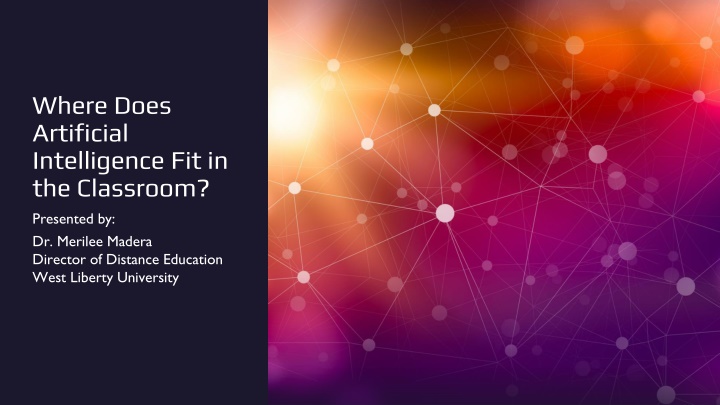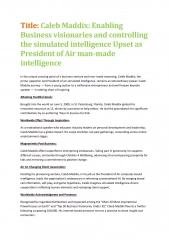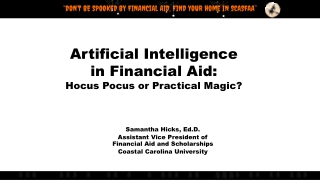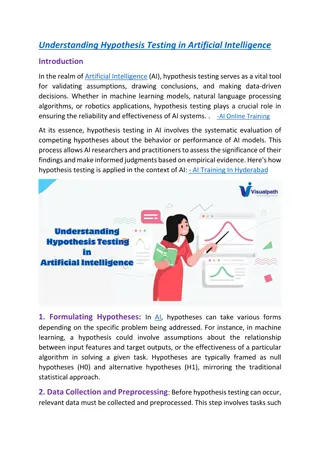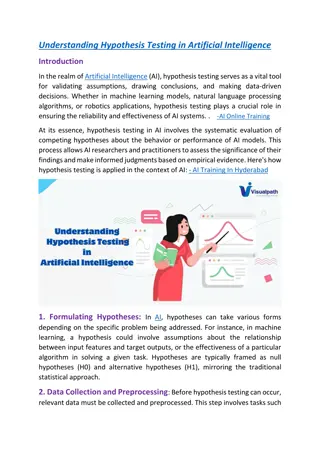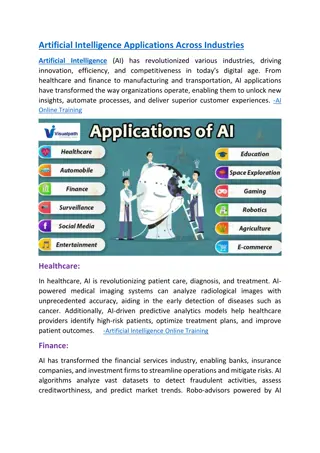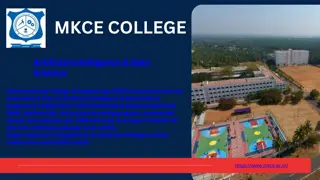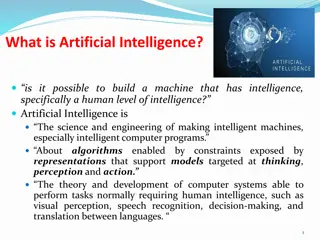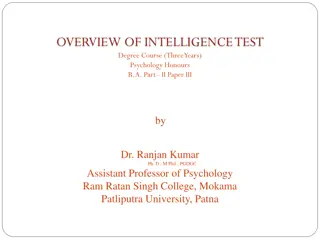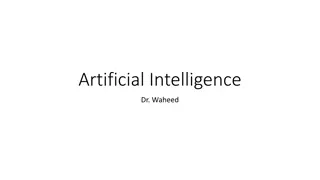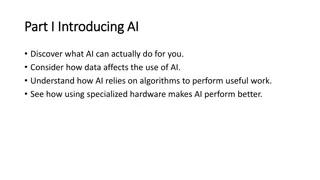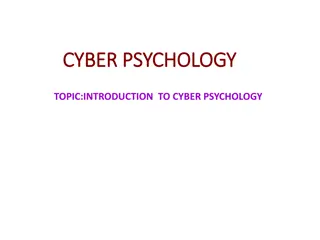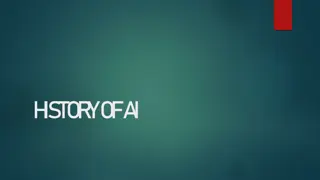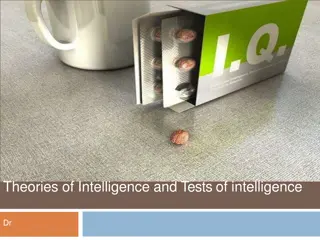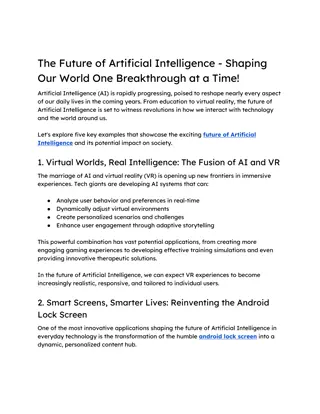Artificial Intelligence in the Classroom: Applications and Evolution
Artificial intelligence (AI) has transformed education by enabling applications to perform complex tasks that once required human input. This timeline explores the evolution of AI from Alan Turing's proposals to the introduction of virtual assistants, chatbots, and self-driving cars. It discusses the different types of AI, including Artificial Narrow Intelligence, Artificial General Intelligence, and Artificial Superintelligence, and their impact on the classroom environment. Learn how AI has shaped the way we teach and learn, paving the path for innovative educational strategies.
Download Presentation

Please find below an Image/Link to download the presentation.
The content on the website is provided AS IS for your information and personal use only. It may not be sold, licensed, or shared on other websites without obtaining consent from the author.If you encounter any issues during the download, it is possible that the publisher has removed the file from their server.
You are allowed to download the files provided on this website for personal or commercial use, subject to the condition that they are used lawfully. All files are the property of their respective owners.
The content on the website is provided AS IS for your information and personal use only. It may not be sold, licensed, or shared on other websites without obtaining consent from the author.
E N D
Presentation Transcript
Where Does Artificial Intelligence Fit in the Classroom? Presented by: Dr. Merilee Madera Director of Distance Education West Liberty University
What is artificial intelligence? Applications that perform complex tasks that once required human input. (Oracle Cloud Infrastructure, n.d., para. 1) 2
(Anyoha, 2017; Javatpoint Services, n.d.; Pregowska & Osial, 2021; Queensland Brain Institute, n.d.) Timeline 1936: Alan Turing proposes that a computing machine would be capable of executing cognitive processes, provided they could be broken down into multiple, individual steps and represented by an algorithm. John McCarthy coined the term artificial intelligence. Progress on AI stalled because computers didn t have enough computational power, databases weren t large enough, and there was a lack of research funds. The Logic Theorist was presented at the DSRPAI conference by Herbert Simon, Allen Newell, and John Clifford Shaw. 1943: Artificial neurons were proposed by Warren McCulloch and Walter Pitts. Pre-1950 1950 1956 1966 1970s Alan Turing published his paper, Computing Machinery and Intelligence and introduces the Turing test, which determines a machine's ability to exhibit intelligent behavior equivalent to, or indistinguishable from, that of a human. Joseph Weizenbaum created the first chatbot, ELIZA. 3
Timeline 2002: Roomba introduces AI to the home. 2006: Amazon starts its cloud computing service. 2007: Apple launches the iPhone. 2009: Google builds the first self- driving car to handle urban conditions. Field reinvigorated with the introduction of expert systems and financial investments such as Japan s Fifth Generation Computer Project. 2022: ChatGPT introduced. The global chatbot market has an estimated value of $6.92 billion in 2023. 1980s 1990s 2000s 2010s 2020s 2011-2014: Virtual assistants (Siri, Alexa, Google Now, Cortana) are introduced. 2011: Watson wins Jeopardy. 2014: Chatbot Eugene Goostman wins a Turing test 1997: IBM s Deep Blue defeated Gary Kasparov and Dragon Systems introduces Naturally Speaking 1.0 voice recognition software. 4
Artificial Narrow Intelligence Also known as weak AI Machines designed to complete very specific actions; unable to independently learn Examples: Alexa, ChatGPT, self-driving cars, and Alpha-Go. Almost all the AI-based systems built to date fall into this category. Types of Learning in Artificial Intelligence Artificial General Intelligence Also known as strong AI Machines designed to learn, think and perform at similar levels to humans Considered by many as a threat to human existence Artificial Superintelligence Machines that surpass the knowledge and capabilities of humans Still hypothetical (Agnihotri, n.d.; Lateef, 2023) 5
Types of AI Systems Reactive Machines Limited Memory Limited AI that only reacts to different kinds of stimuli based on preprogrammed rules. Does not use memory and thus cannot learn with new data. AI that can use memory to improve over time by being trained with new data, typically through an artificial neural network or other training model. Large language models, a type of deep learning algorithm, are considered limited memory artificial intelligence. Good for simple classification and pattern recognition tasks Can beat humans because it can make calculations much faster Current state of AI Examples: ChatGPT, self-driving cars, virtual assistants (Alexa, Siri, etc.) Examples: Deep Blue, spam filters (Agnihotri, n.d.; Bello, 2021; Google Cloud, n.d.; Lateef, 2023) 6
Types of AI Systems Theory of Mind Self-Awareness AI that can emulate the human mind and has decision-making capabilities equal to that of a human including recognizing and remembering emotions and reacting in social situations as a human would. Ultimate goal for researchers in this field A machine that is aware of its own existence and has the intellectual and emotional capabilities of a human. Would not need to borrow consciousness from a model. It will know what it wants and what it has to do. Such a machine will be a living creature in itself. Does not currently exist but research is ongoing into its possibilities. Examples: Robots Kismet and Sophia Considerable ethical debate about this type of AI (Agnihotri, n.d.; Bello, 2021; Google Cloud, n.d.; Lateef, 2023) 7
Photo editing Biometrics Search engines Recommender systems Grammar checkers Smart replies Smart filters Predictive text Chatbots Digital assistants Smart home devices Everyday Uses of AI 8
Adaptive learning Assistive technology Data and learning analytics Gamification for enhanced student engagement Uses of AI in Education Creating assessments Intelligent tutoring systems Generating learning materials Plagiarism detection Chatbots for enrollment and retention Grading Academic research 9
What is ChatGPT? A free chatbot developed by OpenAI (November 2022) Uses a generative pre-trained transformer (GPT-3.5), a type of autoregressive large language model, and has 175 billion parameters. Some estimate that it was trained on around 45 terabytes of text data (equivalent to one million feet of bookshelf space or a quarter of the entire Library of Congress) and was fine-tuned to follow instructions using a combination of supervised training and reinforcement learning from human feedback (RLHF). Can input up to 3,000 words of text ChatGPT Plus (March 2023) $20 per month Uses GPT-4 (estimated to have 1 trillion parameters) Can input up to 25,000 words of text Accepts visual in addition to text inputs Both Versions Have a Knowledge Cutoff of September 2021 (McKinsey Explainers, 2023; OpenAI, n.d.; sarthakhost2.0, 2023; Vivek, 2023) 10
ChatGPT in Action 11
Alternatives to ChatGPT Bard AI (Google) Bing AI (Microsoft) Grammarly MagickPen Jasper Chat Rytr Chatsonic Perplexity 12
Paraphrasing Tools QuillBot Grammarly Wordtune Paraphrase- Online 13
Image Creation DALL-E Canva starryai Craiyon 14
(GPTZero, n.d.; Hartman-Sigall, 2023) AI Detection GPTZero (January 2023) Created by Edward Tian ( 23 Princeton graduate) It predicts whether a document was written by a large language model, providing predictions on a sentence, paragraph, and document level. Uses two metrics to estimate the probability that the text was written by AI: perplexity and burstiness Perplexity measures the randomness of the word choice and construction of a given sentence Burstiness compares perplexity across sentences. ChatGPT works by predicting the most common next word, so the more random the construction of a text both within and across sentences, the more likely it was written by a human. Turnitin (April 2023) Copyleaks Winston AI OpenAI 15
AI Detection General Notes Both GPTZero and Turnitin claim a 98% accuracy rate. Both systems are far more likely to not catch AI writing than falsely classify student work as AI. Neither company recommends taking action again a student solely on the basis of their report. It is much harder for systems to detect text written by GPT-4 than previous versions. It is harder to detect AI writing in shorter works. No standard minimum number of words. OpenAI requires minimum of 1000 characters Rule of thumb is the more words, the more reliable and accurate the detection. (GPTZero, n.d.; OpenAI, n.d.; Turnitin, n.d.) 16
Assessment in the Age of AI Make a policy on AI usage for each of your courses Create assignments that use AI writing as a starting point Focus on the process instead of the final product Incorporate project-based learning scenarios Use the flipped classroom model Be specific with your writing prompts Provide grading rubrics with clear expectations Spot check sources Get to know your students writing as much as possible Consider using Ethical AI Use Checklist for Students from Turnitin Require course-based research Assign content behind the paywall Ask students to show and tell Quiz students on their own work If possible, have students incorporate recent events (Chandy, 2023; Ferlazzo, 2023; Kelley, 2023; McMurtrie, 2023, Turnitin, n.d.) 17
Sample Policies (Colorado State University) THE PROHIBITIVE STATEMENT THE USE-WITH-PERMISSION STATEMENT THE ABDICATION STATEMENT A Note on AI: Any work written, developed, created, or inspired by artificial intelligence (AI) is considered plagiarism and will not be tolerated. While the ever- changing (and exciting!) new developments with AI will find their place in our workforces and personal lives, in the realm of education and learning, this kind of technology does not belong. This is because the use of AI robs us all of the opportunity to learn from our experiences and from each other, to play with our creative freedoms, to problem-solve, and to contribute our ideas in authentic ways. In a nutshell, college is a place for learning, and this class is specifically a space for learning how to improve our writing. AI simply cannot do that learning for us. Generally speaking, you are not authorized to use artificial intelligence engines, software, or artwork generating programs (or similar) to produce work for this class EXCEPT on assignments that I have identified and for which you will have received significant guidance on appropriate use of such technologies. I will provide more information about the specific assignment when the time is appropriate in the course. You may not, however, construe this limited use as permission to use these technologies in any other facet of this course. From this point forward, I will assume that all written work has been co- authored or entirely written by ChatGPT. I will grade such writing as I normally would and your grade will be a reflection of your ability to harness these new technologies as you prepare for your future in a workforce that will increasingly require your proficiency with AI-assisted work. 18
Other Samples Temple University Princeton Texas A&M University Northwestern University Optional Syllabus Statement Regarding AI-generated Content: Any form of cheating, including improper use of content generated by artificial intelligence, constitutes a violation of Northwestern s academic integrity policy. Turnitin, which is already in use at Northwestern, is expanding its system to include artificial intelligence detection. 1. Intellectual honesty is vital to an academic community and for my fair evaluation of your work. All work submitted in this course must be your own, completed in accordance with the University s academic regulations. You may not engage in unauthorized collaboration or make use of ChatGPT or other AI composition software. 2. Students must obtain permission from me before using AI composition software (like ChatGPT) for any assignments in this course. Using these tools without my permission puts your academic integrity at risk. 19
The Future of AI AI will be regarded as one of the technologies that changed history. Goldman Sachs economists estimate that 300 million full-time jobs worldwide could be automated by the current wave of AI with white collar workers being more affected that manual laborers. (Toh, 2023) The ethical questions surrounding further AI development need to be addressed. Recently, a group of tech leaders including Elon Musk and Steve Wozniak called for a 6-month moratorium on AI development to give companies and regulators time to formulate safeguards to protect society from potential risks of the technology. AI should be included in digital literacy programs. Not only how to use the tools but how to fact check and be critical consumers of information AI will not replace teachers but allow us to truly personalize learning. 20
References Agnihotri, N. (n.d.). What are different types of artificial intelligence? Engineers Garage. https://www.engineersgarage.com/what-are-different-types-of-artificial- intelligence/ Javatpoint Services. (n.d.). History of artificial intelligence. https://www.javatpoint.com/history-of-artificial-intelligence Kelley, K. J. (2023, January 18). Teaching actual student writing in an AI world. Inside Higher Education. https://www.insidehighered.com/advice/2023/01/19/ways-prevent- students-using-ai-tools-their-classes-opinion Anyoha, R. (2017, August 28). The history of artificial intelligence. Harvard University, Graduate School of Arts and Sciences. https://sitn.hms.harvard.edu/flash/2017/history-artificial-intelligence/ Lateef, Z. (2023, March 3). Types of artificial intelligence you should know. Edureka. https://www.edureka.co/blog/types-of-artificial-intelligence/ Bello, S. (2021, May 3). 8 examples of artificial intelligence in our everyday lives. EDGY Labs. https://edgy.app/examples-of-artificial-intelligence McKinsey Explainers. (2023, January 19). What is generative AI? McKinsey & Company. https://www.mckinsey.com/featured-insights/mckinsey-explainers/what-is-generative-ai Chandy, B. (2023, February 2). Five ways teachers can integrate ChatGPT into their classrooms today. University of Pennsylvania, Graduate School of Education. https://www.gse.upenn.edu/news/educators-playbook/five-ways-teachers-can- integrate-chatgpt-their-classrooms-today McMurtrie, B. (2023, March 6). ChatGPT is everywhere: Love it or hate it, academics can t ignore the already pervasive technology. The Chronicle of Higher Education. https://www.chronicle.com/article/chatgpt-is-already-upending-campus-practices- colleges-are-rushing-to-respond Ferlazzo, L. (2023, January 18). 19 ways to use ChatGPT in your classroom. EducationWeek. https://www.edweek.org/teaching-learning/opinion-19-ways-to-use- chatgpt-in-your-classroom/2023/01 Office of the Registrar. (n.d.). Syllabus statements. Northwestern University. https://www.registrar.northwestern.edu/faculty-staff/syllabi.html Google Cloud. (n.d.). What is artificial intelligence (AI)? Google. https://cloud.google.com/learn/what-is-artificial-intelligence OpenAI. (n.d.). AI text classifier. https://platform.openai.com/ai-text-classifier OpenAI. (n.d.). GPT-4 is OpenAI s most advanced system, producing safer and more useful responses. https://openai.com/product/gpt-4 GPTZero. (n.d.). What is GPTZero? https://gptzero.me/faq Hartman-Sigall, J. (2023, January 18). Edward Tian 23 creates GPTZero, software to detect plagiarism from AI bot ChatGPT. The Daily Princetonian. https://www.dailyprincetonian.com/article/2023/01/edward-tian-gptzero-chatgpt-ai- software-princeton-plagiarism Oracle Cloud Infrastructure. (n.d.). What is AI? Learn about artificial intelligence. Oracle Corporation. https://www.oracle.com/artificial-intelligence/what-is-ai/ 21
References Pregowska, A., & Osial, M. (2021, August 17). What is an artificial neural network and why do we need it? Frontiers for Young Minds. https://kids.frontiersin.org/articles/10.3389/frym.2021.560631#:~:text=The%20first %20artificial%20neuron%20was,and%20then%20leaves%20the%20perceptron Turnitin. (n.d.). Ethical AI use checklist for students. https://www.turnitin.com/lessons/academic-integrity-in-the-age-of-ai-ethical-ai-use- checklist-for-students Vivek, S. (2023, March 16). What is ChatGPT-4? Here s everything you need to know! TICE. https://www.tice.news/know-this/chatgpt-4-open-ai-artificial-intelligence-features- limitations Queensland Brain Institute. (n.d.). History of artificial intelligence. The University of Queensland. https://qbi.uq.edu.au/brain/intelligent-machines/history-artificial- intelligence sarthakhost2.0. (2023, May 22). Chat gpt 4 parameters, how to use GPT 4, chat gpt 4 features, Login and more. sscnr.net.in. https://sscnr.net.in/chat-gpt-4- parameters/ The Institute for Learning and Teaching. (2023, February 22). What should a syllabus statement on AI look like? Colorado State University. https://tilt.colostate.edu/what-should-a-syllabus-statement-on-ai-look-like/ The McGraw Center for Teaching & Learning. (2023, January 25). Guidance on AI/ChatGPT. Princeton University. https://mcgraw.princeton.edu/guidance- aichatgpt Toh, M. (2023, March 29). 300 million jobs could be affected by latest wave of AI, says Goldman Sachs. CNN. https://www.cnn.com/2023/03/29/tech/chatgpt-ai- automation-jobs-impact-intl-hnk/index.html Turnitin. (n.d.) AI writing detection capabilities frequently asked questions. https://www.turnitin.com/products/features/ai-writing-detection/faq 22
Thank You Dr. Merilee Madera merilee.madera@westliberty.edu (304) 336-8436 23
